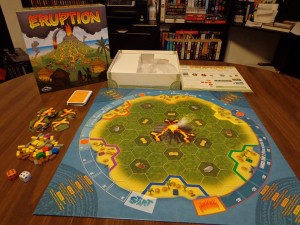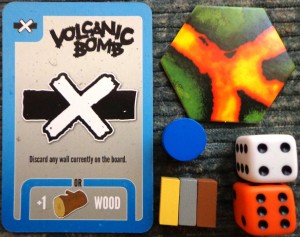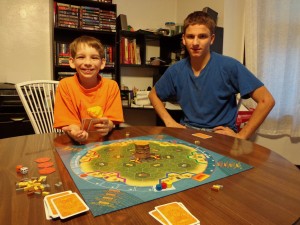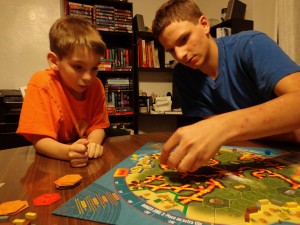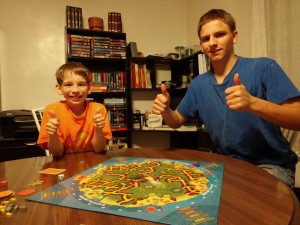It was just another day for the peaceful villagers…hunting, fishing, repairing huts, pushing numbers into a computer to prevent the island from blowing up (watch your LOST, kids)…the usual. Then, all of a sudden, Mother Nature happens in the form of a volcano that threatens to burn everything to the ground. The jury is still out as to whether or not tectonic plates were the cause or if some ten-year old found the disaster menu in SimCity for the first time…nevertheless, the race for survival is on!
Eruption is a game that tasks players with diverting lava flow away from their villages as best they can. If lava does manage to touch their village…well…let’s just say that things will heat up and players will be doing everything they can to prevent or stop that from happening. Before I begin with the usual review format, I’d like to quickly thank Dan Yarrington from Game Salute for sending me a free review copy.
Components
Game Board – The board is made up of hexagonal tiles, with the volcano in the middle and the villages scattered along the perimeter of the island.
Lava Tiles – Lava tiles are placed on the board every turn to simulate lava flow. The art on the tile faces are varied, allowing players to adjust the lava flow away from their village or towards another, if at all possible.
Eruption Tiles – Eruption tiles are special tiles that are placed on the board by players when the temperature of their village reaches a certain point. Eruption tiles serve as new locations for lava tiles to build on.
Walls – Players will be able to build walls to possibly fend off lava flows. Walls can be built around the perimeter of a village as well as further in towards the volcano and can be made up of straw, wood, or stone.
Action Cards – Action cards allow players to either help themselves or hurt an opponent.
Scoring Markers – Each player will have a scoring marker, which moves along a Burn Meter track. Their markers go up the track as lava tiles come into contact with their villages and when eruption tiles are placed. To help unfortunate players out, they are given special abilities as they move further up the track.
Dice – There are two dice, one orange (lava die) and one white (wall die). Both are rolled during certain situations, but the ultimate goal is to determine if the wall manages to hold back the lava or if it gets destroyed and removed from the board.
Setup & Gameplay
First, the deck of action cards is shuffled and each player receives three. The lava tiles are shuffled, stacked, and placed in the center of the board face down. The eruption tiles are placed off to the side for the time being. Each player gets one of each type of wall and picks a village to defend. It’s important that players put as much space in between them as possible. The manual lists out the optimum setup no matter how many people are playing…I’ve linked that later on for your convenience. Players then take the scoring markers of their colors and place them on the “Start” space of the burn meter track. The first player is determined via a die roll.
A player’s turn consists of the following:
1. The player assesses damage to their village by resolving any lava flows that may be in contact with their village. Lava flows that touch their village without resistance are an instant +20 degrees on the burn meter track (+20 per lava flow). If a wall is between a lava flow and their village, dice are rolled to determine if the wall holds (nothing happens) or if it falls (+10 degrees on the burn meter track + wall destroyed).
2. The player will draw a lava tile and place it where they want, assuming that it follows a set of particular rules. I won’t go into all of the tile placement rules, but suffice it to say that in most cases, all new tiles must be placed in a way that “make sense”…that is…lava must connect to lava and regular land must connect to regular land on all sides of the tiles. Please see the below linked manual and video for more detailed information.
3. The player can play as many action cards as they like, so as long as they have three or less left in their hand by the time their turn ends. Action cards list a primary action, but players can opt to collect the resource (wall piece) on the bottom of the card in lieu of performing the action. Players can collect action cards by placing lava tiles so that it connects with ANY village…one card per new lava flow that connects with that village. Players also get to draw action cards if their scoring marker is far enough along the burn meter track.
4. The player can build a single wall, assuming they have any to place. Walls add modifiers to the white dice when it is rolled…straw adds “0”, wood adds “1”, and stone adds “2”. While straw doesn’t add a modifier, it is better than not having a wall there at all as at least it forces a die roll check. Walls can prevent lava tiles from being placed in a particular direction as well as prevent villages from burning up any further along the burn meter track. There are some special rules regarding walls that I haven’t mentioned, so again, please see the below linked manual and video for more information.
Players continue taking turns until one of two things happen:
1. A player’s scoring marker reaches the fire space on the burn meter track and stays there when their turn ends. After that, the remaining players take one last turn.
2. The last lava tile is placed…in which case all players take one last turn.
The winner is the player whose village is the coolest…that is…whose scoring marker is lowest along the burn meter track.
While the above doesn’t go into all of the rules in detail, it should give you an idea of whether or not the game interests you. If you’d like to learn more, you can check out the manual, as well as a helpful tutorial video, here:
The Review
First, I want to comment on the quality of the components. The board itself is very colorful and probably my favorite thing about it is that it includes the steps of a player’s turn along the four corners of the board. This saved me from having to consult the manual quite a few times. The action cards were easy to read and the lava flows were easy to see on the lava tiles. Kudos on excellent and user-friendly components!
The reason I liked having the player steps listed on the board was because at first, I was overwhelmed by a lot of the mechanics. One of the biggest hurdles I had to overcome was how lava tiles were placed and what was considered legal and what wasn’t. There were also a few times where I had to question the placement of a wall and a resulting lava tile, but the manual does a fairly good job in predicting these questions by giving examples of each possibility. It may take a game or two for players to fully grasp the game’s placement mechanics, but I can vouch that the work in learning these things are well worth it.
Once I overcame the hurdle of placing tiles legally, I began to realize how deep the game could be. It was a challenge to keep the lava flowing away from my village while keeping the kids busy with new problems to consider. Some spaces on the board award wall pieces when you place a lava tile on them, so I had to decide if the wall was worth it, even if it meant opening up a possible path to my village. Vinnie (11) and Anthony (16) both did an excellent job in thinking out their next move, even if they seemed to have a feud going on. Both of them were so busy trying to mess with each other that they completely ignored the fact that I was creating paths that would assure that the lava would miss my village. I also came to appreciate that players were rewarded with things as they moved further up to track…this served to help balance the game out and give the less fortunate an opportunity to get back into the game.
All in all, the kids and I had a fun time with Eruption. The random draw of lava tiles not only ensures that each game is new and exciting, but forces players to come up with new strategies and plans on the fly. The tutorial video that I linked earlier is a great way to learn how to play the game and I applaud Stratus Games for making it. There are also variants listed in the manual that help add to this game’s already high replayability factor. While there is a learning curve in regards to tile and wall placement, it didn’t deter me from enjoying this game to its fullest. If you enjoy tile laying games or are just looking for a new game to play on family game night, then give this game a good look!
Final Verdict: 7/10
—
You can learn more about “Eruption” by visiting the Stratus Games website and BoardGameGeek, located here:
—

